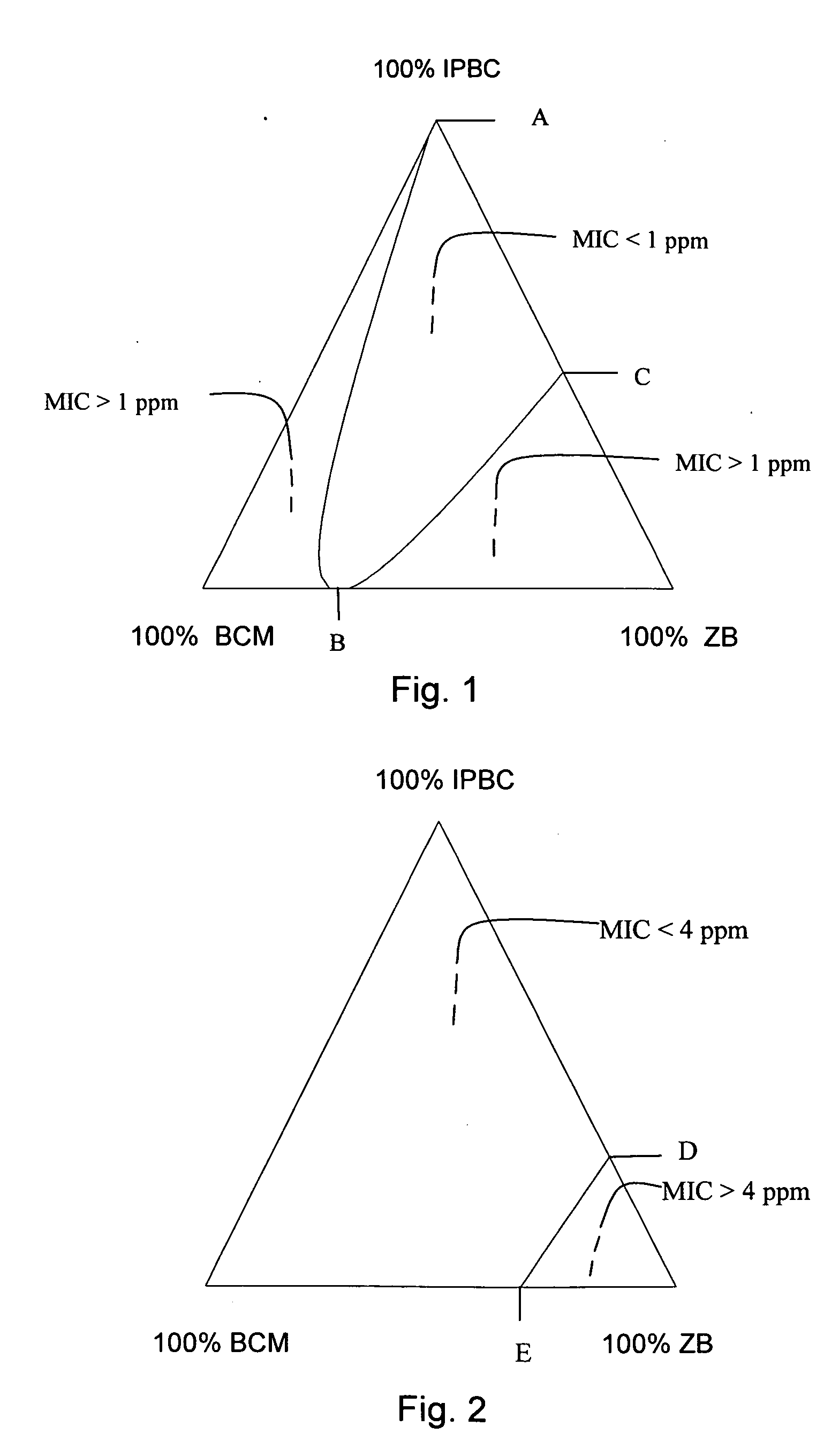Synergistic antimicrobial mixtures
a technology of antimicrobial mixtures and synergistics, applied in the direction of biocides, biocide, fungicides, etc., can solve the problems of not being soluble borates are not generally suitable for exterior or ground contact applications, and no single organic antimicrobial compound can provide protection against all microorganisms or is suitable for all applications
- Summary
- Abstract
- Description
- Claims
- Application Information
AI Technical Summary
Benefits of technology
Problems solved by technology
Method used
Image
Examples
example 1
Preparation of Wood-Plastic Composite Panels including Biocides
[0056]Several candidate biocides were tested in a typical WPC formulation, which is presented below in Table I.
TABLE IFormulation of Wood-Plastic CompositeIngredientDescriptionmass %Petrothene ® LB 0100-00high density 35.4Plastic from Equistar.polyethylenePonderosa Pine Wood Flour60 mesh60.0from American Wood FiberGlycolube ® WP 2200amide-based, 2.0Lubricant from Lonzastearate-freeTinuvin ® 783 FDLoligomeric Hindered 0.3-0.34from CibaAmine Light StabilizerGrey Pigment 191130none 1.0-2.0From AmpacetIrganox 1010 and Irganox thermal stabilizers 0.3Antioxidants from Cibapresent in 2:1 ratioBiocidesee Table II, below20.22-5.51Note 1:Total of ingredients in formulation is 100 mass %. Differences in the mass of an additive ingredient or a biocide ingredient in a particular formulation are compensated by varying Plastic and Wood Flour proportionally.Note 2:The biocide ingredients are described below in Table II.
[0057]WPC panel...
example 2
Outdoor Testing of Wood-Plastic Composite Panels including Biocides
[0058]Wood-plastic composite panels incorporating various biocides were prepared in accordance with the procedure set forth above in Example 1. The panels were evaluated for mildew growth by being exposed to the weather outdoors in Miami, Fla. for one year under a protocol publicly known as ASTM D 3274-94 of ASTM International (originally known as the American Society for Testing and Materials).
[0059]For the purposes of this evaluation, any biocide or combination of biocides which prevents moderate (or worse) mildew growth for an outdoor exposure period of at least 9 months is considered to have passed the weathering test. The results of the evaluation are shown below in Table II.
TABLE IIOutdoor Exposure Evaluation ResultsMass %BiocideMildew Growth1Eval.(Mass %36912No.BiocideActive)MonthsMonthsMonthsMonths1Blank 010866(no biocide)(0)28.3% IPBC2 5.3410925(0.44 )340% IPBC 0.57022(0.2)498% BCM3 0.25124(0.2)599% Zinc Bor...
example 3
Synergistic Effects with Respect to Fungus Aspergillus niger
[0062]Minimum Inhibitory Concentrations (hereinafter referred to as “MIC”) for various mixtures of biocides were determined against spore suspensions of the fungus Aspergillus niger, also known as ATCC 6275 (hereinafter referred to as “A. niger”). The determinations were performed with the aid of an Autoplate 4000 spiral plater, which is commercially available from Spiral Biotech, Inc. of Norwood, Mass.) and appropriate spiral gradient endpoint software (hereinafter referred to as “SGE software”). The spiral plater and SGE software are not a part of the invention nor are they essential for demonstrating its utility. The spiral plater and SGE software conveniently facilitate the performance of a well-known serial dilution method for determining MICs.
[0063]Spore suspensions for the test fungus were prepared by growing Aspergillus niger on a Difco malt agar slant in an incubator for one week at 28 degrees C. Spores were loose...
PUM
| Property | Measurement | Unit |
|---|---|---|
| length | aaaaa | aaaaa |
| length | aaaaa | aaaaa |
| length | aaaaa | aaaaa |
Abstract
Description
Claims
Application Information
 Login to View More
Login to View More - R&D
- Intellectual Property
- Life Sciences
- Materials
- Tech Scout
- Unparalleled Data Quality
- Higher Quality Content
- 60% Fewer Hallucinations
Browse by: Latest US Patents, China's latest patents, Technical Efficacy Thesaurus, Application Domain, Technology Topic, Popular Technical Reports.
© 2025 PatSnap. All rights reserved.Legal|Privacy policy|Modern Slavery Act Transparency Statement|Sitemap|About US| Contact US: help@patsnap.com



